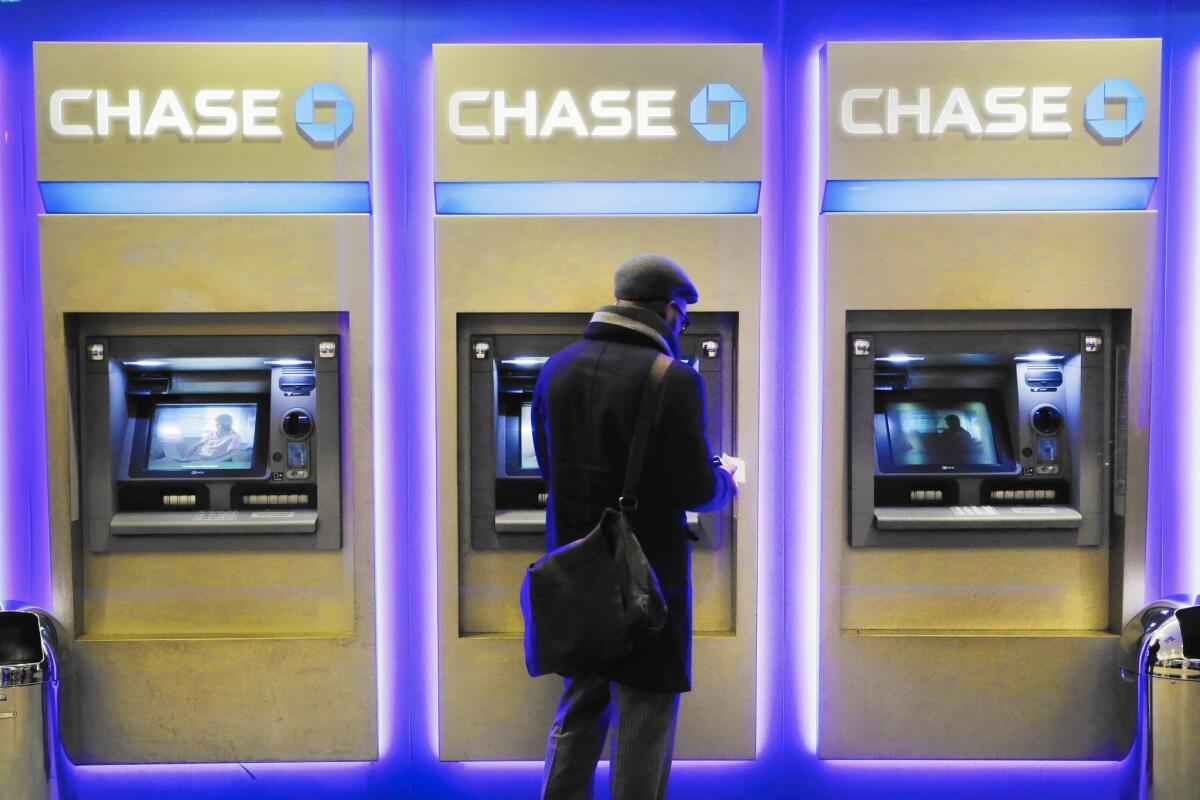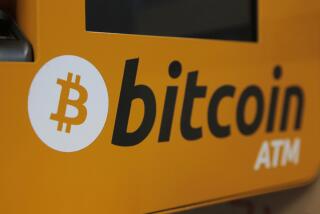Big U.S. banks will roll out ATMs that take smartphones, not cards

The addition of cardless ATMs comes as banks are trying to push customers to do more transactions online, on their phones or through ATMs. Above, at a branch last year in New York.
- Share via
To the long list of things you can do with your phone — including watch a movie, buy a latte and hail a ride — prepare to add one more: get cash.
Over the next few months, the nation’s three biggest banks will start rolling out ATMs that will let customers withdraw currency using their smartphones instead of debit cards — the latest step toward a future in which phones could replace bank branches and wallets.
“My boys are 5 and 6 — I don’t think they’ll carry around plastic when they grow up,” said Michelle Moore, head of digital banking for Bank of America, which plans to make cardless ATMs widely available as early as May.
San Francisco banking giant Wells Fargo plans to offer cardless access at a limited number of ATMs by this summer and at all ATMs by the end of the year. Most of JPMorgan Chase’s ATMs will start offering cardless access sometime in the second half of the year.
Cash machines that work with a phone instead of a card aren’t new, but they are rare. Downtown L.A.’s City National Bank unveiled cardless ATMs in 2013, and a few regional banks have followed suit over the last year, but the number of cardless ATMs now stands in the low thousands nationwide.
Soon, they’ll be much more common, especially in Los Angeles, where Bank of America, Wells Fargo and JPMorgan Chase each have hundreds of ATMs and hold nearly half of all bank deposits. Nationwide, they have a combined 47,000 ATMs, more than 10% of the nation’s cash machines.
The banks’ entry into cardless ATMs comes as a small but growing number of Americans are using their phones to send money to one another and to make purchases using so-called mobile wallet apps such as Apple Pay and Android Pay.
It also comes as banks are trying to push customers to do more transactions online, on their phones or through ATMs — all of which are less expensive than transactions done at branches staffed with tellers.
Just as with mobile wallet payments, which make up a tiny fraction of payments overall, analysts expect using a phone to get cash from an ATM probably will start out as a little-used novelty.
But over the longer term, it could be one more application that will make customers feel comfortable using their devices as financial tools, leading to a general growth in mobile banking, said Mark Schwanhausser, a director at consulting firm Javelin Research & Strategy.
“You’re acclimating people to the techniques of mobile payments,” he said. “It’s like a mobile wallet on training wheels.”
Banks will offer cardless access to ATMs using either near-field communication — the tap-to-pay technology used in Apple Pay and Android Pay that connects phones with credit card payment terminals — or codes that customers get through their bank’s mobile app.
Using near-field communication, or NFC, a customer would sign in to a mobile wallet or bank app, then physically tap the phone on the ATM and enter a PIN.
Bank of America and Wells Fargo plan to roll out NFC access this year, though it will be available only at ATMs equipped with NFC readers.
Wells Fargo expects more than a third of its 13,000 ATMs will have those readers by the end of the year, while more than half of Bank of America’s 16,100 ATMs are already NFC equipped.
Chase also has an NFC system in the works, though spokesman Michael Fusco said he’s not sure when it will roll out.
For now, Chase is starting with a code-based system, which requires a software update for ATMs but no new hardware. Wells Fargo will start offering code-based access late this year.
Those systems require customers to sign in to their bank’s mobile app, request an access code and then type that seven- or eight-digit number into an ATM.
The codes can be used once and expire in about 10 minutes, features that aim to prevent codes from being stolen or misused.
“After that small window of time, it’s a meaningless set of digits that can’t be used again,” said Jonathan Velline, head of ATM banking for Wells Fargo.
Though customers might worry about seeing their bank accounts pillaged if their phone is lost or stolen, Ed O’Brien, a director at bank consulting firm Mercator Advisory Group, said accessing an ATM with a phone could prove more secure than using a card.
Fraudsters can steal debit card numbers and PINs by installing tiny devices on ATMs — a crime known as skimming. Industry estimates put bank losses from ATM fraud at $1 billion in 2008, and it probably has grown since then, according to Mercator.
“The magnetic stripe has an issue of security. Someone can duplicate a magnetic stripe, which does happen all too often,” O’Brien said.
But if a phone is stolen, a thief would have to get past a few layers of security to withdraw cash from an ATM. They’d need to unlock the phone, sign in to the mobile bank app or mobile wallet and, in most cases, know the customer’s PIN.
As the banks prepare to launch cardless access, Bank of America and Chase also are working on more features set to be released later.
Both plan to allow customers to set up an ATM transaction in advance, cutting down on the amount of time they have to spend in front of the machine.
A customer could log in to his bank app and say he wanted to withdraw $150, and that he’d like a $50 bill, four $20s and two $10s — a feature that will be available as the banks also provide more ATMs stocked with multiple types of bills.
Once the transaction is set up, he could go to an ATM, tap his phone, grab the cash and move on. Schwanhausser of Javelin likened it to picking up tickets at will-call instead of buying them at the box office.
And O’Brien of Mercator said being able to spend less time at the ATM could also improve security.
“You get your money in 10 or 12 seconds. You’re not having to look at whether someone is behind you, you don’t have to hide your PIN,” he said.
More to Read
Inside the business of entertainment
The Wide Shot brings you news, analysis and insights on everything from streaming wars to production — and what it all means for the future.
You may occasionally receive promotional content from the Los Angeles Times.











